Recently added
No products
Product successfully added to your shopping cart
There are 0 items in your cart. There is 1 item in your cart.
STRING TYING
Get the Best out of String Tying process.
What it can and cannot do.
Typical equipment for the String Tying:
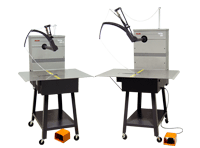 |
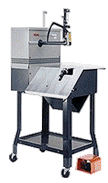 |
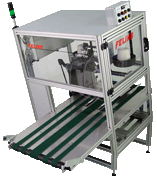 |
 |
| Automatic Felins Pak Tyer 2000-6” |
Automatic Felins Coil Tyer 2000-6” |
Fully Automatic Felins ATS |
Automatisk Felins Rotary Tyer |
Process: The String Tying process starts when the product passes through the machine, in which, the string is tightened by the lead. And then passing the start of keys point and the string is inserted. The attached head node attaches and the string is cut. A new string will then be ready for the next product. Types of string tying materials are LDPE, PET, cotton, elastomer, elastic, viscous and forms as Poly Tape, Twisted Poly and Spiral Twist. The hard products are bound with elastic cords while the soft products are bound with fixed strings.
String Tying only has a few restrictions, since it has no direct influence on the product outcome. When the cord/string is tensioned, it is important to note that the product needs to have sufficient hardness be able to resist the pull of the string, while ensuring sufficient tension around the product, thus it is subsequently tied in a bundle. Minimum length of bundle typically down to 20-25 mm, but lesser may be possible. The height of the arm that ties the circles gives the outer limit.
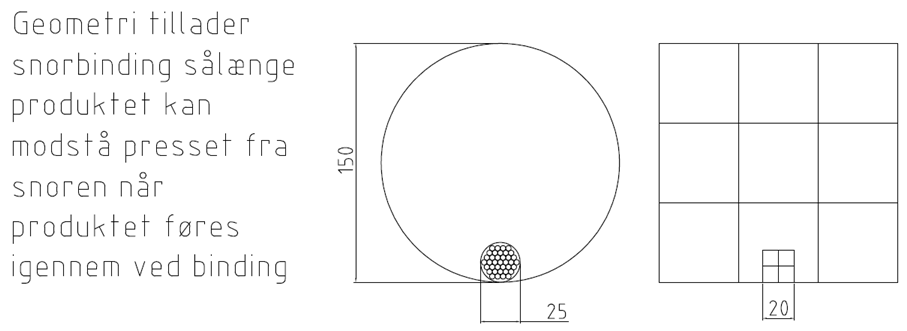
Applicable equipment in relation to different processes:
- Manual:
Manual binding of the products have been around since the first jungle rope, this requires no machinery or equipment. - Semi-automatic:
To my knowledge, there is no equipment for semi-automatic string tying machine. - Automatic:
- String Tying requires an operator. There are 2 main forms:
- The string is placed around the product and is attached to the underside, rotary type. The machines that implement this process is called Rotary Tyers. These machines are often used in the graphics industry, laundries, etc.
- The string is passed down behind the product after it has been inserted into another string. The string passed into the attached head attached and the cord cutters. This type machines that does this process is called linked arm binders. Example machines are Pak Resort 2000 and Coil Resort. These machines are often used in laundries, gardens, cable manufacturers(coil). Alternatives like the right / left version and tandem also apply.
Typical products have been tied with string: - String Tying requires an operator. There are 2 main forms:

- Fully Automatic:
- For laundry, horticulture and industry etc. There is a variety of fully automated solutions where the product is loaded in a position facing the conveyor or on the open belt and then the machine binds the product.
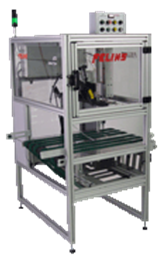
- For laundry, horticulture and industry etc. There is a variety of fully automated solutions where the product is loaded in a position facing the conveyor or on the open belt and then the machine binds the product.
Project specific and more advanced string tying equipment and industry-specific processes can be made on request.
Decommissioning:
Cord/String comes on core typically Ø76 without the core, with cardboard core ø40-50, in a plastic wrapper, often customised for each machine type.
When ordering, the cord/string layup and type of machine is very important to know. You should know in relation to the string tie the string to be used, the number of meters per rewind, termination method, geometric locked or tape.
 Elastic String
Elastic String
Related Areas:
Tying with bands which use a plastic "band" being welded.
Wrapping with ribbon by using plastic or paper "band" that being welded.
Author of Article:
Gunnar Salbæk
CEO / Industrial Design with 20 years of experience in the field.




 E3Hallbrook Ergonomical
Packaging Tables & Solutions
E3Hallbrook Ergonomical
Packaging Tables & Solutions E3Hallbrook Standard Pallet
Wrappers
E3Hallbrook Standard Pallet
Wrappers E3Hallbrook Special Project
Based Pallet Wrappers
E3Hallbrook Special Project
Based Pallet Wrappers
 Manual for PP, PET and WG
strap
Manual for PP, PET and WG
strap Battery tools for PET and
PP
strap
Battery tools for PET and
PP
strap Pneumatic tools for PP and
Steel strap
Pneumatic tools for PP and
Steel strap Strap wagons PP, PET, WG
and
steel strap
Strap wagons PP, PET, WG
and
steel strap Steel Strapping Hand
Tools
Steel Strapping Hand
Tools Pallet strap rods
Pallet strap rods Steep Strap Cutters
Steep Strap Cutters Batteries for Battery
Tools
Batteries for Battery
Tools Semi Automatic strapping
machines
Semi Automatic strapping
machines E3 Hallbrook Ergonomic
strapping solutions
E3 Hallbrook Ergonomic
strapping solutions Pallet strapping
machines
Pallet strapping
machines Side seal strapping
machines
Side seal strapping
machines PP Strap materials
PP Strap materials PET Strap
PET Strap Steep Strap
Steep Strap WG Strap
WG Strap Strapping Machines with
Arch
for 9-12-15,5 mm PP Strap
Strapping Machines with
Arch
for 9-12-15,5 mm PP Strap High Speed 5-6 or 9 mm PP
strap
High Speed 5-6 or 9 mm PP
strap Side seal machines PP
Strap
Side seal machines PP
Strap STEP ZD-08 Table Type Mini
Automatic Strapping Machine
STEP ZD-08 Table Type Mini
Automatic Strapping Machine Full Pallet Bargins for
Strap
Full Pallet Bargins for
Strap High speed transit 5-6 or
9mm PP straping machines
High speed transit 5-6 or
9mm PP straping machines Transit PP strapping
machines 9, 12 or 15,5 mm
Transit PP strapping
machines 9, 12 or 15,5 mm Pallet Strapping
machines
Pallet Strapping
machines Project Strapping
Machines
Project Strapping
Machines Fishing and Food
Industry
Fishing and Food
Industry Corrugated industry,
Strapping Machines for
Corrugated industry,
Strapping Machines for Printing Industry
Printing Industry
 E3 Wrap 2100 Semi Automatic
Pallet Wrapper
E3 Wrap 2100 Semi Automatic
Pallet Wrapper E3 Wrap 2100 Series Special
Applications and Options
E3 Wrap 2100 Series Special
Applications and Options Hand Film Dispenser For
Hand
Film
Hand Film Dispenser For
Hand
Film Top Film Dispensers
Top Film Dispensers STEP Semi-Automatic
Turntable Pallet Wrapper
STEP Semi-Automatic
Turntable Pallet Wrapper STEP Robot Pallet
Wrappers
STEP Robot Pallet
Wrappers STEP Automatic Pallet
Wrappers with Remote Start
STEP Automatic Pallet
Wrappers with Remote Start Fully Automatic Pallet
Wrapping Lines
Fully Automatic Pallet
Wrapping Lines Stretch Hood Pallet
Wrapping
Stretch Hood Pallet
Wrapping Horizontal Wrappers
Horizontal Wrappers
 Banding Materials
Banding Materials Banding Machines Table
Top
Banding Machines Table
Top STEP M-Series Banders Tape, Label, Stretch, and Automated Stacker Machines
STEP M-Series Banders Tape, Label, Stretch, and Automated Stacker Machines STEP String Tiers
STEP String Tiers String for Tying
String for Tying
 Portable Sealers
Portable Sealers Hand Impulse Sealers
Hand Impulse Sealers Foot Stand Sealer
Foot Stand Sealer I-Bar Impulse Sealers
I-Bar Impulse Sealers Automatic Impulse
Sealers
Automatic Impulse
Sealers Band Sealers
Band Sealers Pharmaceutical Sealers
Pharmaceutical Sealers Tube Film on rolls
Tube Film on rolls Packaging of Food
Packaging of Food Sack Tiers, Drill Tool
Sack Tiers, Drill Tool Bag and Sack closers with
tape
Bag and Sack closers with
tape Bag Closing Machines with
Sewing
Bag Closing Machines with
Sewing Thread for Sewing
Machines
Thread for Sewing
Machines Sack & Bag closing
lines
with sewing machines
Sack & Bag closing
lines
with sewing machines PE Bags for Sealers
PE Bags for Sealers Aluminum Vacuum Bags
Aluminum Vacuum Bags
 Polyolefin Shrink Film
Polyolefin Shrink Film PE Shrink Film
PE Shrink Film Heat Shrink Guns
Heat Shrink Guns Skin Packaging
Skin Packaging Shrink Packaging Machines
& Systems
Shrink Packaging Machines
& Systems
 STEP AGV Solutions
STEP AGV Solutions STEP Robotics, Robots &
Grippers
STEP Robotics, Robots &
Grippers Belt Conveyors
Belt Conveyors Vibrators, Product feed
& sorting
Vibrators, Product feed
& sorting Vacuum Lifting &
Handling Systems
Vacuum Lifting &
Handling Systems Telescopic Unloading
Conveyors & Systems
Telescopic Unloading
Conveyors & Systems Weighing Scale - Pallet
& Platform Scales
Weighing Scale - Pallet
& Platform Scales
 Multihead Weighers
Multihead Weighers Mini Table Top Weighers
Mini Table Top Weighers VFFS Packaging Machines
VFFS Packaging Machines Doybag Packaging
Machines
Doybag Packaging
Machines Flow Pack Machines
Flow Pack Machines Rotary Fillers
Rotary Fillers Vacuum/Gas Horizontal Flow
Packaging
Vacuum/Gas Horizontal Flow
Packaging VFFS Packaging Lines
VFFS Packaging Lines Conveyors for Multihead
& VFFS packaging lines
Conveyors for Multihead
& VFFS packaging lines
 Carton Closing
Carton Closing Tape Dispensers
Tape Dispensers Tapemeter
Tapemeter Tapes and Adhesive
Rolls
Tapes and Adhesive
Rolls Protection in Rolls
Cardboard-Bubble-Foam
Protection in Rolls
Cardboard-Bubble-Foam Manual and Pneumatic
Staplers
Manual and Pneumatic
Staplers Carton Erectors
Carton Erectors
 Document Pouches
Document Pouches Protection in Rolls, foam,
card board
Protection in Rolls, foam,
card board PP, PET, Steel strap, WG
strap
PP, PET, Steel strap, WG
strap Cardboard Boxes
Cardboard Boxes Stretch film & Hand
wrap
film
Stretch film & Hand
wrap
film Shrink film
Shrink film Topfilm for paller
Topfilm for paller Strings for Packaging
Strings for Packaging Bags for Packaging
Bags for Packaging Seals, metal buckels and
plastic buckles
Seals, metal buckels and
plastic buckles Banding tape
Banding tape Kraft Paper, Fidele,
Packaging Paper
Kraft Paper, Fidele,
Packaging Paper Film knives and Clips
removers
Film knives and Clips
removers Corner and Edge
Protection
Corner and Edge
Protection Manila labels, Manila clips
& Rubber bands
Manila labels, Manila clips
& Rubber bands Labels for Packaging
Labels for Packaging Packaging Tapes
Packaging Tapes
 Production Machines for
Sample Making
Production Machines for
Sample Making
 Battery for Battery
tensioners and sealers
Battery for Battery
tensioners and sealers Used Packaging Machines
Used Packaging Machines